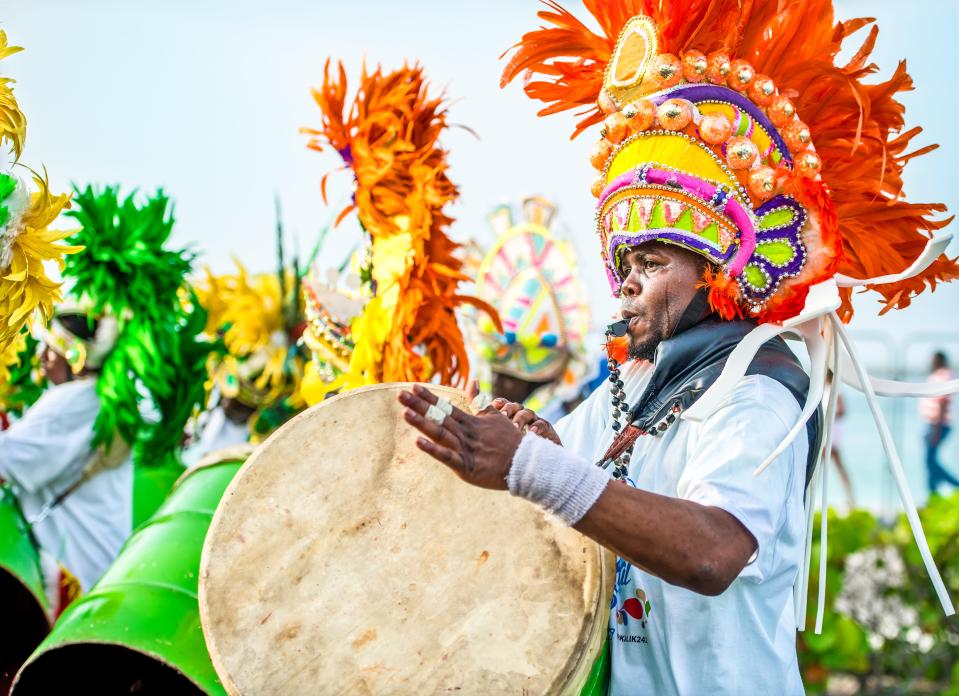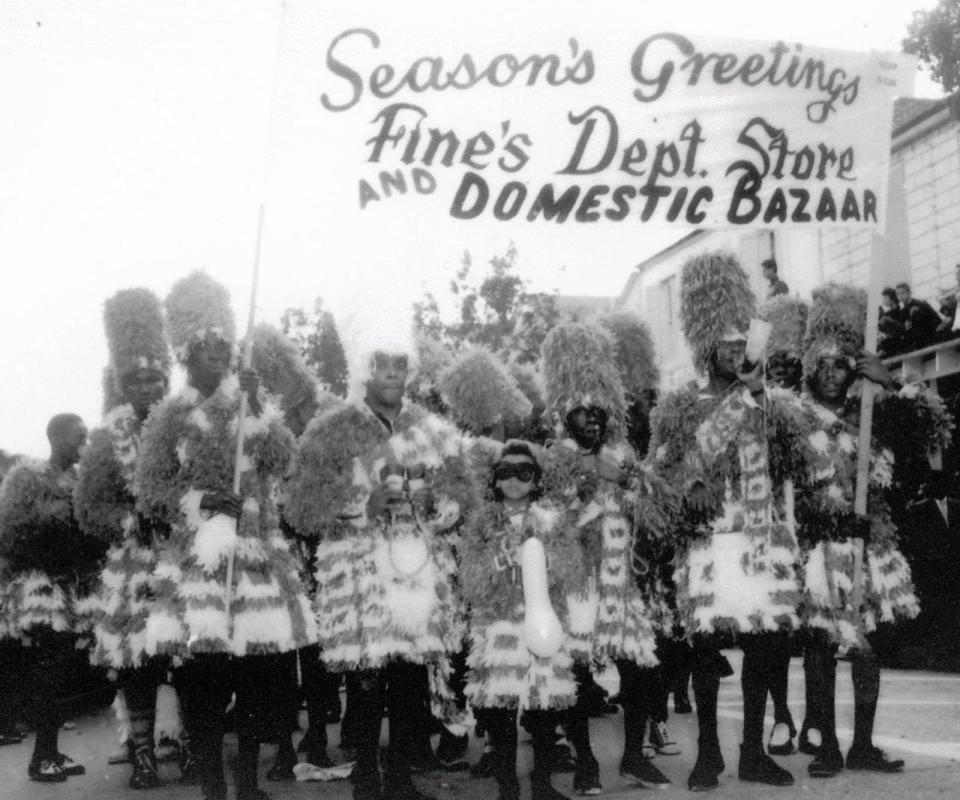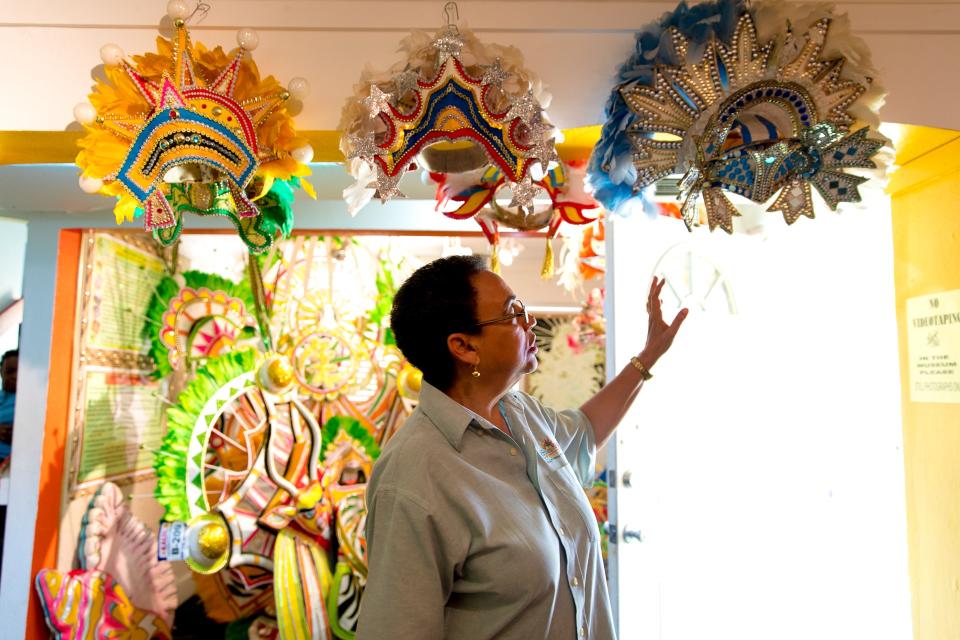Junkanoo Joy in The Bahamas

When the holidays roll around, many people experience one of two emotions: excitement or dread.
Those falling into the latter camp and hoping to escape the season altogether may want to find themselves at Junkanoo.
More from WWD
The longstanding, color-rich, music-invigorated festival that speaks to the spirit of The Bahamas will be back beginning in the wee hours of Dec. 26 after a two-year pandemic-induced pause.
And the people of the Caribbean isles are ready to “rush,” as they refer to their rhythmic participation in the parade.
The essence of Junkanoo, as Arlene Nash Ferguson — who locals have dubbed the Queen of Junkanoo — explains, “is a spirit that is almost impossible to put into words.” The heartbeat of the parade pulses in Nassau, along the island nation capital’s busy Bay Street to be exact, though it is celebrated across all 16 islands.
“I cannot begin to tell you what Junkanoo does to and for the people of The Bahamas,” says Nash Ferguson, also founder of the Educulture Junkanoo Museum, which tells the story and history of the festival. “At Junkanoo…the music is the core of the festival.”
Setting it apart from how Carnival manifests across many other islands in the Caribbean, which carry on to the soundtrack of the season’s soca music recordings, with each island bringing its own vibes and variations, Junkanoo’s music is always played live. And conch shell horns, local goat skin Goombay drums, whistles and brass are the stars of the auditory show.

“Our drummers have their drums strapped across the shoulder, they’re beating them with their hands and not with sticks. Our bellers are shaking their cowbells and so the music is right there. And when those drums ‘lick off,’ as people would say, when those drums start booming, it is just so difficult to describe,” Nash Ferguson says. “I am 72 years old. I was in the parade from [when] I was four. My costumes this year — there are two parades — are well underway. And the only thing apart from God’s grace and mercy that would allow me to dance down Bay Street for hours in this towering costume is those drums…when that euphoria hits you, yeah. You’ve just got to go.”
Junkanoo, despite its high energy and fete-like atmosphere, has a history that runs much deeper than a street party.
“Junkanoo in The Bahamas is a centuries old festival, and it developed in the hearts and the souls of enslaved Africans who found themselves transported across a frightening expanse of ocean to a land that, however beautiful, was not their own, and the journey was not their choice,” says Nash Ferguson, author of “I Come to Get Me!: An Inside Look at the Junkanoo Festival.”

As with many age-old stories documented by colonizers rather than the original people of the land, or those brought in and enslaved, there are gaps to fill in what likely took place. But broadly, according to Nash Ferguson, enslaved Africans were granted three days holiday during Christmas time under British law.
With that time, “in the cover of night, they stole away to reclaim their heritage,” Nash Ferguson says.
That’s why Junkanoo begins before dawn, typically Christmas night into Boxing Day (Dec. 26) morning. Part two of the festivities takes place to celebrate the New Year, with paraders assembling New Year’s Eve and “rushing” through the morning of the first day of the year.
After the music, it’s the costumes that give Junkanoo its essence and reflect its history. And these works of wearable art are made in what locals call “shacks,” dedicated specifically to the cultural craft.
“When [people] come into the shack to get their costumes at the beginning of the season, it struck me that they don’t say, ‘I come to get my costume.’ They say, ‘Man, I come to get me,’ [hence the name of Nash Ferguson’s book and a way for paraders to say they’re coming to reclaim themselves],” Nash Ferguson says. “And I say to myself, they do not know the story of when their ancestors went into the bush in dark of night to reclaim their heritage and reclaim their souls.”
Junkanoo costumes are often made using cardboard reclaimed from local furniture stores and businesses that discard it, layered by hand with colorful crepe paper, beaded and whipped into creations that color the island’s streets. There are Junkanoo families or formal parade troupes — complete with choreographed dancers — divided into divisions based on size, with costume themes kept under lock and key until early December.
Christina Fernander, a Junkanoo costume designer, dancer and former choreographer who leads the One Family Junkanoo and Community Organization group and has been participating in the parade since childhood, has watched the costumes evolve over time. Now what she creates follows on tradition, but also brings in a fresh take.
“When I started, you couldn’t tell the difference between the males’ and the females’ [costumes]. Everybody wore basically the same thing: a [cardboard] pasted pants, shirt, hat and shoulder piece,” she says. “Female costumes have now become more feminine and more delicate. You get to express yourself more correctly when you’re portraying a character.”
Now light foam materials that sometimes sub for cardboard and feathers, thanks in part to influence from other Caribbean carnivals, Fernander says, have also found their way into Junkanoo costumes.
This year, Fernander and her group are creating costumes around the theme “Rise of the Warriors.”
“There hasn’t been any Junkaoo for the past few years due to the pandemic and so our theme is really based around where we came from, where we’ve been within the last two years and the obstacles that we’ve overcome,” she says. As such, paraders will appear as different warriors with costumes crafted to suit.
In all, Junkanoo is about celebration — of life, freedom, joy, culture and community. It’s what’s at the core of the Bahamian spirit.
“The spirit of Junkanoo comes from within for me,” Fernander says. “It’s an out-of-this-world experience when you go down Bay Street and all of the costumes put together with the music, the drums, and you perform and you give it your all for those thousands of persons that come out to watch and support you, then you know at the end of the day it was all worth it. All of the months of hard work were all worth it.”
For foreigners looking to do more than drink, sample treats like Bahamian cracked conch (a deep fried fish dish) and spectate on the sidelines for a chance to be close to that local euphoria, Junkanoo’s “F,” or “Fun Division,” has groups that will organize packages with drinks, snacks and partial costumes, plus a meeting place to begin the parade partying. Locals call it the “people’s rush.”
Coupled with the festival, shuffling through white sand on screamingly turquoise beaches tends to beat shoveling snow if your standard holiday locale is a cold one.
Consider it an alternative kind of joy to the world.

Best of WWD

